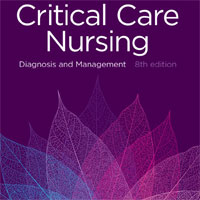Tag: diagnosis
Deep Medicine: How Artificial Intelligence Can Make Healthcare Human Again
Medicine has become inhuman, to disastrous effect. The doctor-patient relationship--the heart of medicine--is broken: doctors are too distracted and overwhelmed to truly connect with their patients, and medical errors and... read more

Prognostic Accuracy of the Serum Lactate Level, the SOFA Score and the qSOFA Score for Mortality Among Adults with Sepsis
Sepsis is a common critical condition caused by the body’s overwhelming response to certain infective agents. Many biomarkers, including the serum lactate level, have been used for sepsis diagnosis and guiding treatment.... read more
Critical Care Nursing – Diagnosis and Management
Get a firm understanding and mastery of the unique issues and procedures involved in critical care nursing with Critical Care Nursing: Diagnosis and Management, 8th Edition. Praised for its comprehensive coverage and clear... read more

Antibiotics for Sepsis – Finding the Equilibrium
Sepsis is medicine’s last remaining preserve for unrestrained antibiotic prescribing. The Surviving Sepsis Campaign guidelines recommend empirical broad-spectrum therapy within one hour of triage for both sepsis and septic... read more
Feasibility, Safety, and Utility of Advanced Critical Care Transesophageal Echocardiography Performed by Pulmonary/Critical Care Fellows in a Medical ICU
Critical care transesophageal echocardiography is feasible, safe, and has clinical utility. It can be safely and effectively performed by fellows within the context of their critical care training with faculty supervision.... read more
European Guideline on Managing Post-traumatic Bleeding: 5th Edition
An updated guideline on the management of significant bleeding and coagulopathy following major trauma has been released by the pan-European, multidisciplinary Task Force for Advanced Bleeding Care in Trauma. The document,... read more
Safety of Early Tracheostomy in Trauma Patients After Anterior Cervical Fusion
Cervical spine injuries (CSIs) can have major effects on the respiratory system and carry a high incidence of pulmonary complications. Respiratory failure can be due to spinal cord injuries, concomitant facial fractures or... read more
Expanding the Differential for Hypotension in the Pediatric Patient
As many ED practitioners are aware, food allergies are common in the first 2 years of life, with a prevalence cited between 1-10% of the population. Most food allergies are IgE-mediated hypersensitivity reactions. Food protein-induced... read more
Acute Hyperglycemic Emergencies
As diabetes prevalence increases in the US, critical care nurses need to be familiar with the acute hyperglycemic emergencies they may encounter in the ED or ICU. This article focuses on the diagnosis of, various treatments... read more
How Artificial Intelligence Can Make Healthcare Human Again
Medicine has become inhuman, to disastrous effect. The doctor-patient relationship, the heart of medicine, is broken: doctors are too distracted and overwhelmed to truly connect with their patients, and medical errors and... read more

Antibiotic timing in Severe Sepsis
Severe sepsis is a time dependent condition and this study builds on previous literature which supports that early identification and treatment of sepsis with antibiotics decreases mortality. Retrospective analysis of a large... read more
ICU Utilization for Patients With Acute Exacerbation of COPD Receiving Noninvasive Ventilation
There is wide variability in the rate of ICU utilization for noninvasive ventilation across hospitals. Chronic obstructive pulmonary disease (COPD) patients receiving noninvasive ventilation had similar in-hospital mortality... read more
Sepsis Incidence and Mortality are Underestimated in Australian ICU Administrative Data
When compared with the reference standard — prospective clinical diagnosis — ANZICS CORE database criteria significantly underestimate the incidence of sepsis and overestimate the incidence of septic shock, and also result... read more
Overuse of troponin? A comprehensive evaluation of testing in a large hospital system
Troponin assays are integral to the diagnosis of acute myocardial infarction (AMI), but there is concern that testing is over utilized and may not conform to published guidelines. We reviewed all testing performed at 14 hospitals... read more
Procedure Eases Complications Related to Fluid Around Lungs
As people live longer with more advanced stages of cancer or chronic diseases, the longer their complications must be treated. That can include pleural effusions, an unusually large amount of fluid around a person’s lungs... read more
Insulin-Treated Diabetes Reduces Dysglycemia-Related Mortality in Sepsis
Patients with sepsis and a pre-existing diagnosis of insulin-treated diabetes (ITD) may show a different relationship between hospital mortality and highest glucose levels and glycemic variability in the first 24 hours than... read more
Are “Sniffer” Systems Effective in Detecting ARDS?
Acute respiratory distress syndrome (ARDS) results in substantial mortality but remains underdiagnosed in clinical practice. For this reason, automated "sniffer" systems that analyse electronic records have been developed... read more
Patient-tailored Triage Decisions by Anesthesiologist-staffed Prehospital Critical Care Teams
The primary objective was to estimate the incidence of patients in the Central Denmark Region triaged to bypass the local emergency department without being part of a predefined fast-track protocol. The secondary objective... read more
Effect of a Program Combining Transitional Care and Long-term Self-management Support on Outcomes of Hospitalized Patients With COPD
In a single-site randomized clinical trial of patients hospitalized due to Chronic obstructive pulmonary disease (COPD), a 3-month program that combined transition and long-term self-management support resulted in significantly... read more
New Sickle Cell Test Can Transform Screening
Sickle cell disease is common throughout much of sub-Saharan Africa. It affects up to 3% of births in some areas and is associated with very high mortality. Many cases go undiagnosed in regions where there are few resources,... read more
Seeing the Present Through the Past
As an MD-PhD candidate, now in the second year of a history of medicine PhD, I often reflect on the role of history in the medical school classroom and at the bedside. Medical history is a useful way to understand the roots... read more
The combination of procalcitonin and C-reactive protein or presepsin alone improves the accuracy of diagnosis of neonatal sepsis
The combination of PCT and CRP or presepsin alone improves the accuracy of diagnosis of neonatal sepsis. However, further studies are required to confirm these findings. A total of 28 studies enrolling 2661 patients were... read more









